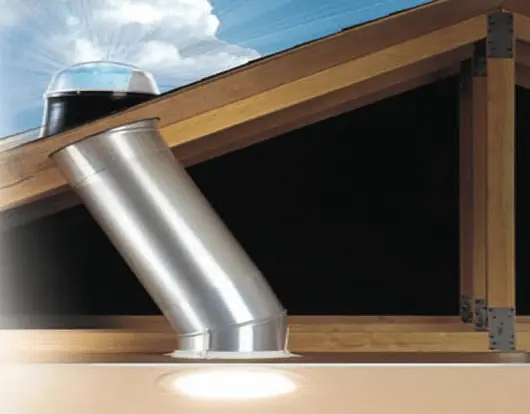Adding inexpensive lighting to your home may sound like a job for LED bulbs or some other new technology, but it can be much simpler and lead to lower electric bills – skylights. And I’m not talking about the skylights that are basically windows in your roof, I am talking about solar tubes.
What is a solar tube?
A solar tube, also known as a sun tunnel or a tubular skylight, is a 10-14 inch sheet metal tube with a mirror-like finish on the inside. The interior finish acts as a reflector to bring as much sunlight from the roof level down to where you want it inside your house.
On the roof is a plastic globe that allows the sunlight to enter the tube, with a weatherproof or flashing surrounding it.
How much do solar tubes cost?
They can run from $500 to over $1000 when someone installs it professionally, which depends on the complexity of your roof and where you live. If you can manage to install it yourself, you can get one in for around $200-$400. Typical skylights can run upwards of $2000.
Another benefit over a traditional skylight is that solar tubes do not require drywall, paint and alteration of framing members in your roof truss area.
How effective are they?
A ten-inch tube is the same as installing a group of three 100-watt bulbs, which is adequate for a space of 200 square feet. A 14-inch tube can provide light for up to 300 square feet. They are perfect for areas where light is always welcome (i.e. not over your bed or TV) and for smaller or awkward spaces like hallways, stairways, bathrooms, laundry rooms and mudrooms.
Is your house right for a solar tube?
Since they require so little to install, there are not many situations where a solar tube would not work well, but there are some things you need to check first:
- Check the attic space above the room to see if there is adequate space to fit a tube. Solar tubes do allow for some bending around obstacles, but just be aware of how much bending will be needed.
- Make sure the roof slope is compatible with the solar tube roofing kit. Many come with flashing that works with 15-60 degree roof slope.
- Make sure that the roofing material matches the flashing kit as well, with the standard being for asphalt shingles.
- Standard rafters are spaced 16 inches apart on-center, enough to fit a 10-14 inch tube. Double check this spacing before buying a solar tube.
- Ensure your solar tube will receive enough sun. The southern exposure provides the most sun (in the northern hemisphere) so try and take advantage of that. Keep in mind that the further you install the globe from the room you are trying to illuminate, the less effective the light will be.
Solar tubes can be a great addition to your home providing an easy way to save electricity that is fairly simple to install. If you have any questions about your roof, siding, insulation or windows, be sure to call the Pros at 888-776-1998 or visit our estimates page to schedule an appointment.

